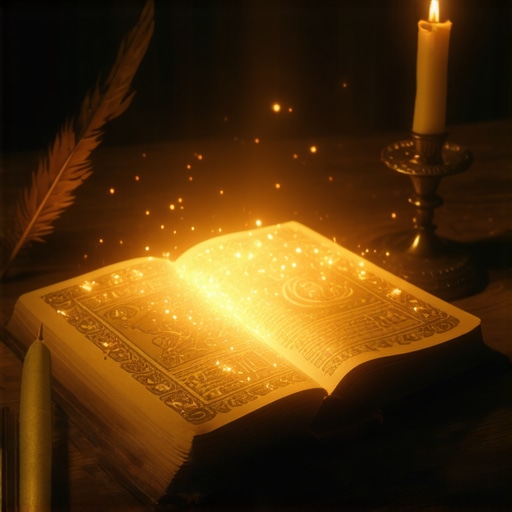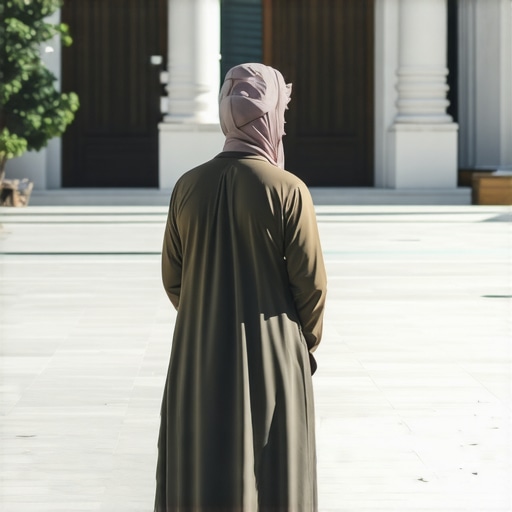My First Encounter with the Mystical World of Dreams
Ever since I was young, I have been fascinated by the mysterious language of dreams. One night, I had a vivid dream of a shimmering snake coiled around a sacred tree, and it left me pondering its deeper meaning. That dream sparked my curiosity to explore the profound symbolism behind dreams and how they connect to divine messages and spiritual insights.
Discovering the Power of Sacred Dream Symbols
As I delved into the Dream Interpretations Book, I realized that dreams are not mere random images but sacred messages from the spiritual realm. I learned that symbols like snakes, cats, and rivers hold specific meanings in Islamic dream interpretations, revealing divine guidance or warnings. This knowledge transformed my understanding of dreams from confusing visions into meaningful signs that can guide my life.
How Do I Interpret My Dreams Accurately?
One question that often arises is, how can I be sure that my dream is a divine message and not just my subconscious? To answer this, I found that consistent symbols across different dreams and their alignment with Islamic teachings are good indicators. For instance, dreaming of a snake in Islam can symbolize various meanings such as hidden enemies or spiritual awakening, depending on the context. Consulting a trusted Islamic dream interpreter or referencing a reliable dream dictionary helps clarify these symbols.
My Personal Tips for Dream Clarity and Spiritual Growth
To enhance my dream awareness, I adopted practices like praying after waking up and reciting the Quran, which is recommended in Islamic traditions. These actions help me receive clearer messages and foster a stronger spiritual connection. I also keep a dream journal to note recurring symbols and their meanings, which deepens my understanding over time.
What Are the Sacred Symbols That Most Resonate With Your Spiritual Path?
If you’re exploring the world of dreams, I encourage you to reflect on the symbols that appear frequently in your visions. Sharing your experiences in the comments can also create a supportive community where we learn from each other’s spiritual journeys. Remember, dreams are sacred, and decoding their messages can be a transformative experience.
If you’re eager to deepen your understanding, I suggest exploring authoritative resources like Ibn al-Qayyim’s insights on dreams, which provide profound interpretations rooted in Islamic scholarship.
Exploring the Nuances of Dream Symbols in Islamic Traditions
Dreams have always been considered a sacred channel for divine communication in Islam. Unlike ordinary visions, Islamic dream symbols often carry layered meanings that require careful interpretation. For example, dreaming of water can signify purity and spiritual cleansing, but depending on the context, it might also represent divine mercy or divine obstacles (source). Understanding these symbols demands not just knowledge but also intuition cultivated through prayer and reflection.
How Can You Discern Divine Messages from Subconscious Images?
This question is central for believers seeking clarity. Experts suggest that consistency in symbols across multiple dreams and their alignment with Islamic teachings often indicate divine origin. For example, seeing the Kaaba in a dream can be a powerful sign of spiritual closeness and divine favor, especially if accompanied by feelings of peace and reverence. Conversely, dreams filled with chaos or fear might be tests or warnings (source). Consulting knowledgeable scholars or trusted dream dictionaries can help decode these signs accurately.
Incorporating Practical Steps to Enhance Dream Interpretation
To deepen your understanding, consider integrating specific practices into your spiritual routine. Reciting Surah Al-Fatiha or Ayat Al-Kursi before sleep can help in receiving clearer messages. Additionally, maintaining a detailed dream journal allows you to track recurring symbols and their meanings, revealing patterns over time. Engaging with community forums or groups dedicated to Islamic dream interpretation can also provide valuable perspectives and support.
What Symbols Are Most Common and How Do They Guide Us?
Some symbols recur frequently in Islamic dreams and have well-established interpretations. For instance, a dream of pregnancy often symbolizes new beginnings or divine blessings, while meeting a prophet in a dream might indicate divine guidance or forthcoming good news. Recognizing these symbols and their contexts enhances your ability to interpret dreams accurately, fostering spiritual growth and awareness.
For more detailed insights, exploring resources like Ibn al-Qayyim’s teachings can deepen your understanding of sacred dream symbolism rooted in classical Islamic scholarship.
Have you ever experienced a dream that seemed to carry a divine message? How did you interpret it, and what was its impact on your spiritual journey?
Sharing personal experiences can enrich our collective understanding and help others recognize the sacred signs in their lives. Remember, dreams are not only personal but also part of a divine conversation, waiting to be deciphered with patience and faith.
Unveiling the Mystical Layers of Dream Symbols
As I continued my journey into the intricate world of Islamic dream interpretation, I realized that many symbols possess layered meanings that transcend their surface appearances. For instance, dreaming of water might initially symbolize purity and divine mercy, but in a deeper context, it can also represent spiritual cleansing or obstacles that test our faith. This nuanced understanding requires not only knowledge but also an intuitive connection cultivated through prayer and reflection.
How Do I Differentiate Between Personal and Universal Symbols?
One of the most profound questions I encountered was, how can I distinguish between symbols that are personally meaningful versus those with universal divine significance? Based on my experience, symbols like a mosque or the Kaaba often carry shared prophetic meanings, signifying divine guidance or spiritual closeness. However, personal symbols—such as a specific animal or color—may hold unique significance rooted in individual life circumstances or spiritual states. Keeping a detailed dream journal helps me track recurring symbols and interpret their evolving meanings in my personal journey, always aligning them with Islamic teachings.
What Advanced Techniques Enhance My Dream Interpretation Skills?
To deepen my understanding, I adopted advanced techniques like contextual analysis—considering the dream’s setting, emotions, and interactions—and consulting authoritative resources such as Ibn al-Qayyim’s insights. These methods help me decode layered messages and recognize divine guidance amidst complex visions. Additionally, engaging in regular prayer before sleep, like reciting Surah Al-Fatiha, enhances my receptivity to sacred messages, creating a spiritual environment conducive to meaningful dreams.
Can Dreams Reflect Personal Spiritual Tests or Divine Rewards?
Another reflection I often ponder is whether dreams serve as tests from Allah or as signs of divine rewards. For example, dreaming of a Prophet or a holy place might indicate divine favor, while dreams filled with chaos or fear could be spiritual tests or warnings. Recognizing these nuances requires not only interpretative skill but also a sincere heart and piety. Consulting trusted scholars or using comprehensive dream dictionaries like Islamic dream dictionaries aids in discerning these divine messages accurately.
Sharing Personal Experiences: A Path to Collective Wisdom
I encourage fellow believers to share their dream encounters—especially those that felt divinely significant. Personal stories enrich our collective understanding and deepen our spiritual bonds. Reflecting on dreams that brought clarity or guidance can inspire others to pay closer attention to their visions, fostering a community rooted in faith and divine trust. Remember, each dream is a sacred dialogue, waiting for us to listen with patience and devotion.
Further Exploration: Deepening Your Connection with Sacred Symbols
If you wish to explore more, I recommend studying classical texts like Ibn al-Qayyim’s teachings, which offer profound insights into the symbolism and spiritual significance of dreams in Islam. These resources can help you develop a more nuanced understanding, transforming dreams from fleeting images into meaningful messages that guide your spiritual path.
Deciphering the Multilayered Significance of Sacred Dream Symbols
Deep within the realm of Islamic dream interpretation lies a labyrinth of symbols whose meanings extend beyond the superficial. As I have journeyed through this sacred landscape, I have come to appreciate that symbols like water or fire are not merely literal images but gateways to profound spiritual truths. For instance, dreaming of water can symbolize divine mercy, spiritual cleansing, or even obstacles that test our faith, depending on the dream’s context and emotional tone. This layered understanding is rooted in classical scholarship, such as the insights provided by Ibn al-Qayyim, who emphasized the importance of context and internal states when interpreting dreams.
How Do I Cultivate Intuitive Discernment of Divine Messages?
Beyond textual knowledge, developing an intuitive sensitivity is essential for accurately decoding dreams. This process involves prayer, reflection, and a sincere heart. Regularly reciting verses like Surah Al-Fatiha or Ayat Al-Kursi not only purifies the heart but also elevates one’s receptivity to divine signals. Additionally, keeping a detailed dream journal enables me to track recurring symbols and emotional patterns, which over time reveal subtle messages from the spiritual realm. Engaging in community discussions or consulting trusted scholars further refines this discernment, transforming raw symbols into meaningful guidance.
What Advanced Techniques Help Distinguish Personal Symbols from Universal Divine Signs?
Distinguishing personal symbols from those with universal divine significance requires a nuanced approach. Personal symbols—such as a specific animal or color—are often tied to individual life circumstances or spiritual states. Meanwhile, universally recognized symbols like the Kaaba or Prophet Muhammad (peace be upon him) carry collective prophetic meanings. To navigate this complexity, I utilize contextual analysis, examining the dream’s setting, the emotional response, and the interactions involved. Consulting authoritative dream dictionaries, such as the comprehensive Islamic Dream Dictionary, provides valuable insights that help me differentiate these layers of meaning effectively.
Integrating Sophisticated Methods for Enhanced Dream Interpretation
For those seeking to elevate their interpretative skills, advanced methods such as cross-referencing dream symbols with Quranic verses and Hadiths are invaluable. For example, dreaming of a mosque or the sight of the Prophet (peace be upon him) can be cross-verified with Quranic descriptions or prophetic traditions to confirm their spiritual significance. Moreover, contextual analysis—considering the dream’s environment, emotional tone, and interactions—enables a holistic understanding. Regular spiritual practices like reciting specific supplications before sleep, combined with reflective meditation, create an environment conducive to receiving clearer, more accurate divine messages.
Can Dreams Serve as Divine Tests or Rewards in Islamic Theology?
This question has profound implications for believers striving to understand their visions. Dreams may act as divine tests, challenging one’s patience and faith, or as signs of divine favor and guidance. For instance, a dream involving the Prophet or sacred sites may indicate divine approval, whereas chaotic or frightening visions could be tests or warnings, as noted in Islamic scholarly works. Recognizing these nuances requires piety, sincerity, and ongoing consultation with knowledgeable scholars. Such discernment transforms dreams from fleeting images into meaningful dialogues with the divine, fostering spiritual resilience and growth.
Conclusion: Embodying Inner Reflection and Sacred Knowledge
Ultimately, mastering the art of sacred dream interpretation demands a harmonious blend of textual knowledge, intuitive sensitivity, and spiritual discipline. As I continue to explore this divine language, I invite you to deepen your engagement by reflecting on your dreams and sharing your experiences. Each vision can serve as a sacred sign, guiding you toward greater understanding and closeness to Allah. Remember, the journey of decoding dreams is a continuous process—one that enriches our faith and aligns our hearts with divine wisdom.
Things I Wish I Knew Earlier (or You Might Find Surprising)
The Power of Personal Symbols
Looking back, I realize that I underestimated how deeply personal symbols in dreams can influence my spiritual growth. Recognizing that certain colors or animals hold unique meanings for each individual helped me interpret dreams more accurately. For instance, a recurring dream about water suddenly became clearer once I understood its connection to my emotional state and divine mercy.
The Importance of Context
Initially, I thought dream symbols had fixed meanings, but I soon learned that context matters greatly. Dreaming of a snake could mean temptation or spiritual awakening, depending on the scene and feelings involved. This nuance transformed my understanding and made dream interpretation a more reflective process.
Consistent Reflection Enhances Clarity
Keeping a dream journal was a game-changer. By noting symbols, emotions, and circumstances, I discovered patterns that revealed divine messages I might have missed otherwise. This practice deepened my connection with my subconscious and the divine guidance it offers.
Seeking Knowledge from Trusted Resources
Relying on authentic sources like Ibn al-Qayyim’s insights provided me with profound interpretations rooted in Islamic scholarship. These resources helped me distinguish between personal and universal symbols, making my dreams more meaningful.
The Role of Prayer and Reflection
Incorporating prayer before sleep, such as reciting Surah Al-Fatiha, has been vital. It creates a spiritual environment that enhances receptivity to divine messages. Reflection upon dreams after waking solidifies their significance and guides my actions.
Recognizing Dreams as Divine Communication
Over time, I came to see dreams as sacred dialogues from Allah. They can serve as tests, warnings, or messages of guidance. Trusting this divine connection has strengthened my faith and encouraged me to pay closer attention to my visions.
Resources I’ve Come to Trust Over Time
- Ibn al-Qayyim’s teachings: His profound insights into dreams have been invaluable, helping me interpret symbols within an Islamic framework.
- Islamic Dream Dictionary: This comprehensive resource offers detailed meanings of various dream symbols, making it easier to decode visions accurately.
- Authentic Islamic Hadith collections: These provide context and guidance on the spiritual significance of dreams, enriching my understanding of divine communication.
- Community forums on Islamic dreams: Engaging with knowledgeable believers has fostered shared learning and support in my spiritual journey.
Parting Thoughts from My Perspective
Deciphering sacred dream symbols is a deeply personal yet universally meaningful pursuit that can significantly enhance your spiritual journey. From understanding the layered meanings of symbols like water or snakes to employing practical tools like prayer and journaling, each step brings you closer to divine guidance. Remember, dreams are sacred messages from Allah, waiting to be understood with patience, faith, and reflection. If this resonates with you, I’d love to hear your experiences. Sharing our journeys can inspire others and strengthen our collective connection to the divine through dreams.



Reading about your transformative journey into Islamic dream interpretation really resonates with me. I’ve also experienced dreams with powerful symbols, like water or animals, that initially seemed just parts of my subconscious but later revealed deeper spiritual meanings after reflection and prayer. I especially appreciate your emphasis on keeping a dream journal; I’ve found that noting recurring themes helps me recognize divine signals over time. Have you encountered a dream that challenged your understanding, perhaps needing guidance from a scholar or a specific resource? I believe that as we deepen our knowledge and trust in Allah’s signs, our ability to interpret dreams accurately grows, enriching our spiritual connection. It’s inspiring to see how practical steps like reciting Surah Al-Fatiha before sleep can enhance receptivity to divine messages. I wonder, what personal techniques have you found most effective for differentiating between personal and universal symbols in your dreams? Sharing these insights can truly benefit others in our community who seek to understand these sacred signs more clearly.